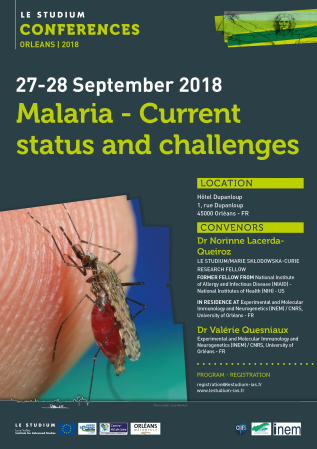Dr Norinne Lacerda-Queiroz

From
National Institute of Allergy and Infectious Disease (NIAID) - National Institutes of Health (NIH) - US
In residence at
Experimental and Molecular Immunology and Neurogenetics (INEM) / CNRS, University of Orléans - FR
Host scientist
Dr Valérie Quesniaux
PROJECT
Study of pulmonary damage in experimental severe Malariav: Malaria-Associated acute respiratory distress syndrome (MA-ARDS) and Malaria Sepsis Induced by secondary bacterial infection
Plasmodium parasites annually infect hundreds of millions of people and complications known as severe malaria lead to half a million deaths. Severe malaria includes cerebral malaria (CM), acute respiratory distress syndrome (ARDS), and severe anemia. Experimental cerebral malaria induced by P. berghei ANKA infection is a relevant model to study some severe malaria-related manifestations. However, the rapid death of infected animals deeply limits the study of other malaria-associated syndromes.
In this study, we propose to investigate the immunopathology of two pulmonary often-lethal major but neglected complications: malaria-associated acute respiratory distress syndrome (MA-ARDS) and malaria sepsis induced by secondary bacterial infection.
First, we aim to characterize the endothelial-leukocyte interactions in a new rodent model of MA-ARDS, using C57BL/6 mice infected with P. berghei NK65. We hypothesize that CD8+ T cells display a detrimental role in the context of pulmonary endothelial interaction and damage, through the involvement of adhesion molecules (LFA-1 and VLA-4) and granzyme release, respectively. Since septic disorders are associated with the development of ARDS, we are planning in a second part to examine the mechanisms of pulmonary damage in the context of secondary bacterial challenge, focusing on the role of free heme-associated cell death.
Together, this study will add significant data in regards to malaria-associated pulmonary syndromes. A complete understanding of the complexity and diversity of severe malaria complications is essential for the development of new therapeutic approaches.
Publications
Cigarette smoke exposure is a leading cause of chronic obstructive pulmonary disease (COPD), a major health issue characterized by airway inflammation with fibrosis and emphysema. Here we demonstrate that acute exposure to cigarette smoke causes respiratory barrier damage with the release of self-dsDNA in mice. This triggers the DNA sensor cGAS (cyclic GMP-AMP synthase) and stimulator of interferon genes (STING), driving type I interferon (IFN I) dependent lung inflammation, which are attenuated in cGAS, STING or type I interferon receptor (IFNAR) deficient mice. Therefore, we demonstrate a critical role of self-dsDNA release and of the cGAS-STING-type I interferon pathway upon cigarette smoke-induced damage, which may lead to therapeutic targets in COPD.
Final reports
Malaria is one of the most important parasitic infection in the world. Cerebral and pulmonary complications may occur after infection and are often lethal. Immune response plays an important role in controlling malaria infection; however, excessive inflammatory response can lead to severe disease. The present work aims to decipher the cellular and molecular events associated with brain and pulmonary pathology in response to blood stage Plasmodium berghei ANKA (PbA) infection. PbA infection in C57BL/6 wild-type (WT) mice induces experimental cerebral malaria (ECM), associated with strong pro-inflammatory response, brain damage, as well as paralysis, coma early death (around day 7 p.i.). Interestingly, IFNγ receptor deficient mice (IFNγR1-/-, C57BL/6 background) are resistant to ECM and died at a later time-point, due to the hyperparasitaemia and severe anemia. Here, we addressed the impact of IFNγR1 deficiency in the development of pulmonary damage during PbA infection. At day 7 post-infection, the broncho-alveolar lavage (BAL) allowed the quantitative analysis of total cells and proteins in the broncho-alveolar space of the animals. In addition, histological analysis and Western blot were performed to compare the cerebral and pulmonary compartments. As compared to PbA-infected WT mice, the histological sections confirmed a less intense accumulation of leukocytes as well as an absence of hemorrhages in the brains of IFNγR1-/- mice. In addition, the quantification of pro-apoptotic proteins (Granzyme B and cleaved caspase-3) in olfactory bulbs showed lower levels in IFNγR1-/- mice. While IFNγR1 deficient mice were fully resistant to brain pathology, those mice were partially protected for pulmonary damage, as observed by the levels of Granzyme B and cleaved caspase-3 in the lung parenchyma, leukocyte number in the broncho-alveolar space and pulmonary edema.



